Detailed Injection Strategy Analysis of a Heavy-Duty Diesel Engine Running on Rape Methyl Ester
Abstract
:1. Introduction
2. Materials and Methods
- Varying the 1st and the 2nd pilot SOI in the range from 70 CAD BTDC to 10 CAD BTDC with 5 CAD increments;
- Varying the pilot injection fuel mass in the range from 1.75 mg to 15.75 mg with increments of 1.75 mg, when the first pilot mass is equal to the second one;
- Varying the post SOI in the range from 0 CAD after top dead center (ATDC) to 30 CAD ATDC with increment of 5 CAD;
- Varying the post injection fuel mass in the range from 3.5 mg to 14 mg with increments of 1.75 mg.
- Verifying the model on fossil DF, using experiment data (verifying the model on alternative fuel experiment data, if possible);
- Making a plan of the optimization experiment;
- Defining the output evaluating parameters;
- Setting optimization parameters and making the calculation grid;
- Changing the type of fuel if desired (if necessary) and run the optimization;
- Processing of calculation results.
3. Results and Discussions
3.1. Two Pilot Injections
3.1.1. First Pilot SOI Optimization
3.1.2. The Design of the Experiment Simulation
3.1.3. Pilot Injection Fuel Mass Optimization
3.1.4. Main Injection SOI Optimization
3.1.5. Post Injection Parameters Optimization
3.2. Single Pilot Injection
3.2.1. Pilot Injection Optimization
3.2.2. Pilot Injection Fuel Mass Optimization
3.2.3. Main SOI Optimization
3.2.4. Post Injection Parameters Optimization
4. Conclusions
Author Contributions
Funding
Institutional Review Board Statement
Informed Consent Statement
Data Availability Statement
Conflicts of Interest
References
- Kobashi, Y.; Wang, Y.; Shibata, G.; Ogawa, H.; Naganuma, K. Ignition control in a gasoline compression ignition engine with ozone addition combined with a two-stage direct-injection strategy. Fuel 2019, 2491, 154–160. [Google Scholar] [CrossRef]
- Shim, E.; Park, H.; Bae, C. Comparisons of advanced combustion technologies (HCCI, PCCI, and dual-fuel PCCI) on engine performance and emission characteristics in a heavy-duty diesel engine. Fuel 2020, 26215, 116436. [Google Scholar] [CrossRef]
- Jafari, H.; Yang, W.; Ryu, C. Evaluation of a distributed combustion concept using 1-D modeling for pressurized oxy-combustion system with low flue gas recirculation. Fuel 2020, 2631, 116723. [Google Scholar] [CrossRef]
- Gohn, J.; Gainey, B.; Zainul, S.; Lawler, B. Wet ethanol in LTC: How water fraction and DTBP affect combustion and intake temperature at naturally aspirated and boosted conditions. Fuel 2020, 2671, 117094. [Google Scholar] [CrossRef]
- Belgiorno, G.; Di Blasio, G.; Shamun, S.; Beatrice, C.; Tunestål, P.; Tunér, M. Performance and emissions of diesel-gasoline-ethanol blends in a light duty compression ignition engine. Fuel 2018, 217, 78–90. [Google Scholar] [CrossRef]
- Benajes, J.; Pastor, J.V.; García, A.; Monsalve-Serrano, J. The potential of RCCI concept to meet EURO VI NOx limitation and ultra-low soot emissions in a heavy-duty engine over the whole engine map. Fuel 2015, 159, 952–961. [Google Scholar] [CrossRef]
- Tripathi, G.; Sharma, P.; Dhar, A.E. Effect of methane augmentation on combustion stability and unregulated emissions in compression ignition engine. Fuel 2020, 2631, 116672. [Google Scholar] [CrossRef]
- Calam, A.; Aydoğan, B.; Halis, S. The comparison of combustion, engine performance and emission characteristics of ethanol, methanol, fuel oil, butanol, isopropanol and naphtha with n-heptane blends on HCCI engine. Fuel 2020, 2615, 117071. [Google Scholar] [CrossRef]
- Benajes, J.; García, A.; Monsalve-Serrano, J.; Villalta, D. Benefits of E85 versus gasoline as low reactivity fuel for an automotive diesel engine operating in reactivity controlled compression ignition combustion mode. Energy Convers. Manag. 2018, 159, 85–95. [Google Scholar] [CrossRef]
- Mortimer, N.D.; Cormack, P.; Elsayed, M.A.; Horne, R.E. Evaluation of the Comparative Energy, Global Warming and Socio-Economic Costs and Benefits of Biodiesel. UK Department for Environment, Food and Rural Affairs (DEFRA), Sheffield Hallam University. 2003. Available online: http://sciencesearch.defra.gov.uk/Default.aspx?Menu=Menu&Module=More&Location=None&Completed=0&ProjectID=10701 (accessed on 20 March 2021).
- Well-to-Wheels Analysis of Future Automotive Fuels and Powertrains in the European Context. Joint Research Centre, EUCAR & CONCAWE. 2007. Available online: https://publications.jrc.ec.europa.eu/repository/handle/JRC65998 (accessed on 22 March 2021).
- European Environment Agency. Transport and Environment: Facing a Dilemma: TERM 2005: Indicators Tracking Transport and Environment in the European Union; European Environment Agency: Copenhagen, Denmark; Luxembourg, 2006. [Google Scholar]
- Kozlov, A.V.; Terenchenko, A.S.; Sister, V.G.; Ivannikova, E.M.; Eliseeva, O.A. A mathematical model for the complete life cycle of biodiesel fuel. Chem. Pet. Eng. 2009, 45, 301–307. [Google Scholar] [CrossRef]
- IEA Renewables. 2019. Available online: https://www.iea.org/reports/renewables-2019/transport#abstract (accessed on 25 February 2021).
- Han, Z.; Uludogan, A.; Hampson, G.; Reitz, R. Mechanism of Soot and NOx Emission Reduction Using Multiple-injection in a Diesel Engine. SAE Tech. Pap. 1996, 12, 960633. [Google Scholar]
- FIRE. Users Manual; Version 2019.R2; AVL List GmbH: Graz, Austria, 2019. [Google Scholar]
- Azimov, U.B.; Kim, K.S.; Jeong, D.S.; Lee, Y.G. Evaluation of low-temperature diesel combustion regimes with n-Heptane fuel in a constant-volume chamber. Int.J. Automot. Technol. 2009, 10, 265–276. [Google Scholar] [CrossRef]
- Azimov, U.; Ki-Seong, K.; Choongsik, B. Modeling of flame lift-off length in diesel low-temperature combustion with multi-dimensional CFD based on the flame surface density and extinction concept. Combust. Theory Model. 2010, 14, 155–175. [Google Scholar] [CrossRef]
- Frolov, S.M.; Frolov, F.S.; Basara, B. Simple model of transient drop vaporization. J. Russ. Laser Res. 2006, 27, 562–574. [Google Scholar] [CrossRef]
- Duzynski, A. (Ed.) Proceedings of the VI International Scientific Conference GAS ENGINES, Czestochova, Poland, 16–18 October 2003; p. 751.
- Eichlseder, H.; Klell, M. Wasserstoff in der Fahrzeugtechnik. Erzeugung, Speicherung, Anwendung; Vieweg—Teubner Verlag: Wiesbaden, Germany, 2008; Volume 288. [Google Scholar]
- Eichlseder, H.; Spuller, C.; Heidl, R.; Gerbig, F.; Heller, K. Konzepte für die Dieselähnliche Wasserstoffverbrennung. MTZ 2010, N1, 60–66. [Google Scholar] [CrossRef]
- Liu, A.B.; Reitz, R.D. Modeling the Effects of Drop Drag and Break-up on Fuel Sprays. SAE Tech. Pap. 1993, 17, 930072. [Google Scholar]
- Naber, J.D.; Reitz, R.D. Modeling Engine Spray/Wall Impingement. SAE Tech. Pap. 1988, 22, 880107. [Google Scholar]
- Agafonov, G.L.; Nullmeier, M.; Vlasov, P.A.; Warnatz, J.; Zaslonko, I.S. Kinetic Modeling of Solid Carbon Particle Formation and Thermal Decomposition during Carbon Suboxide Pyrolysis behind Shock Waves. Combust. Sci. Technol. 2002, 174, 1–29. [Google Scholar] [CrossRef]
- Appel, J.; Bockhorn, H.; Frenklach, M. Kinetic Modeling of Soot Formation with Detailed Chemistry and Physics: Laminar Premixed Flames of C2 Hydrocarbons. Combust. Flame 2000, 121, 122–136. [Google Scholar] [CrossRef]
- Krestinin, A.V. Detailed Modeling of Soot Formation in Hydrocarbon Pyrolysis. Combust. Flame 2000, 121, 513–524. [Google Scholar] [CrossRef]
- Myung, Y.K.; Seung, H.Y.; Chang, S.L. Impact of Split Injection Strategy on the Exhaust Emissions and Soot Particulates from a Compression Ignition Engine Fueled with Neat Biodiesel. Energy Fuels 2008, 22, 1260–1265. [Google Scholar]
- Kweon, C.; Foster, D.E.; Schauer, J.J.; Okada, S. Detailed chemical composition and particle size assessment of diesel engine exhaust. SAE Pap. 2002, 2002, 17. [Google Scholar]
- Kholghy, M.R.; Weingarten, J.; Sediako, A.D.; Barba, J.; Lapuerta, M.; Thomson, M.J. Structural effects of biodiesel on soot formation in a laminar coflow diffusion flame. Proc. Combust. Inst. 2017, 36, 841–851. [Google Scholar] [CrossRef]
- Hampson, G.J.; Reitz, R.D. Two-color imaging on in-cylinder soot concentration and temperature in a heavy-duty DI diesel engine with comparison to multidimensional modeling for single and split injections. J. Eng. 1998, 107, 659–682. [Google Scholar]
- Reitz, R.D. Controlling DI diesel engine emissions using multiple injections and EGR. Combust. Sci. Technol. 1998, 138, 257–278. [Google Scholar] [CrossRef]
- Nakagome, K.; Shimazaki, N.; Niimura, K.; Kobayashi, S. Combustion and Emission Characteristics of Premixed Lean Diesel Combustion Engine. J. Eng. 1997, 106, 1528–1536. [Google Scholar]
- Najt, P.M.; Foster, D.E. Compression-Ignited Homogeneous Charge Combustion. SAE 1983, 20, 830264. [Google Scholar]
- Gajendra, S.; Akhilendra, P.S.; Avinash, K.A. Experimental investigations of combustion, performance and emission characterization of biodiesel fueled HCCI engine using external mixture formation technique. Orig. Res. Artic. Sustain. Energy Technol. Assess. 2014, 6, 116–128. [Google Scholar]
- Mathivanan, K.; Mallikarjuna, J.M.; Ramesh, A. Influence of multiple fuel injection strategies on performance and combustion characteristics of a diesel fueled HCCI engine—An experimental investigation. Orig. Res. Artic. Exp. Ther. Fluid Sci. 2016, 77, 337–346. [Google Scholar] [CrossRef]
- Kuleshov, A.S. Use of Multi-Zone DI Diesel Spray Combustion Model for Simulation and Optimization of Performance and Emissions of Engines with Multiple Injection. SAE Tech. Pap. Ser. 2006. [Google Scholar] [CrossRef]
- Karra, P.K.; Veltman, M.K.; Kong, S.-C. Characteristics of Engine Emissions Using Biodiesel Blends in Low-Temperature Combustion Regimes. Energy Fuels 2008, 22, 3763–3770. [Google Scholar] [CrossRef]
- Punov, P.; Gechev, T.; Mihalkov, S.; Podevin, P.; Barta, D. Experimental study of multiple pilot injection strategy in an automotive direct injection diesel engine. MATEC Web Conf. 2018, 234, 03007. [Google Scholar] [CrossRef]
- Mei, D.; Yu, Q.; Zhang, Z.; Yue, S.; Tu, L. Effects of Two Pilot Injection on Combustion and Emissions in a PCCI Diesel Engine. Energies 2021, 14, 1651. [Google Scholar] [CrossRef]
- Park, S.H.; Yoon, S.H.; Lee, C.S. Effects of multiple-injection strategies on overall spray behavior, combustion, and emissions reduction characteristics of biodiesel fuel. Appl. Energy 2011, 88, 88–98. [Google Scholar] [CrossRef]
- Akhilendra, P.S.; Avinash, K.A. Fuel-Injection Strategy for PCCI Engine Fueled by Mineral Diesel and Biodiesel Blends. Energy Fuels 2017, 31, 8594–8607. [Google Scholar]
- Meloni, R.; Naso, V. An Insight into the Effect of Advanced Injection Strategies on Pollutant Emissions of a Heavy-Duty Diesel Engine. Energies 2013, 6, 4331–4351. [Google Scholar] [CrossRef] [Green Version]
- Horibe, N.; Bao, Z.; Taguchi, T.; Egoshi, K.; Kawanabe, H.; Ishiyama, T. Improvement of Thermal Efficiency in a Diesel Engine with High-PressureSplit Main Injection. SAE Tech. Pap. 2018. [Google Scholar] [CrossRef] [Green Version]
- O’Connor, J.; Musculus, M. Post injections for soot reduction in diesel engines: A review of current understanding. SAE Int. J. Eng. 2013, 6, 400–421. [Google Scholar] [CrossRef] [Green Version]
- Jeftic, M.; Zheng, M. A study of the effect of post injection on combustion and emissions with premixing enhanced fueling strategies. Appl. Energy 2015, 157, 861–870. [Google Scholar] [CrossRef]
- Bobba, M.; Musculus, M.; Neel, W. Effect of post injections on in-cylinder and exhaust soot for low-temperature combustion in a heavy-duty diesel engine. SAE Int. J. Eng. 2010, 3, 496–516. [Google Scholar] [CrossRef]
- Desantes, J.; Arregle, J.; Lopez, J.; Garcia, A. A comprehensive study of diesel combustion and emissions with post-injection. SAE Pap. 2007, 116, 542–550. [Google Scholar]

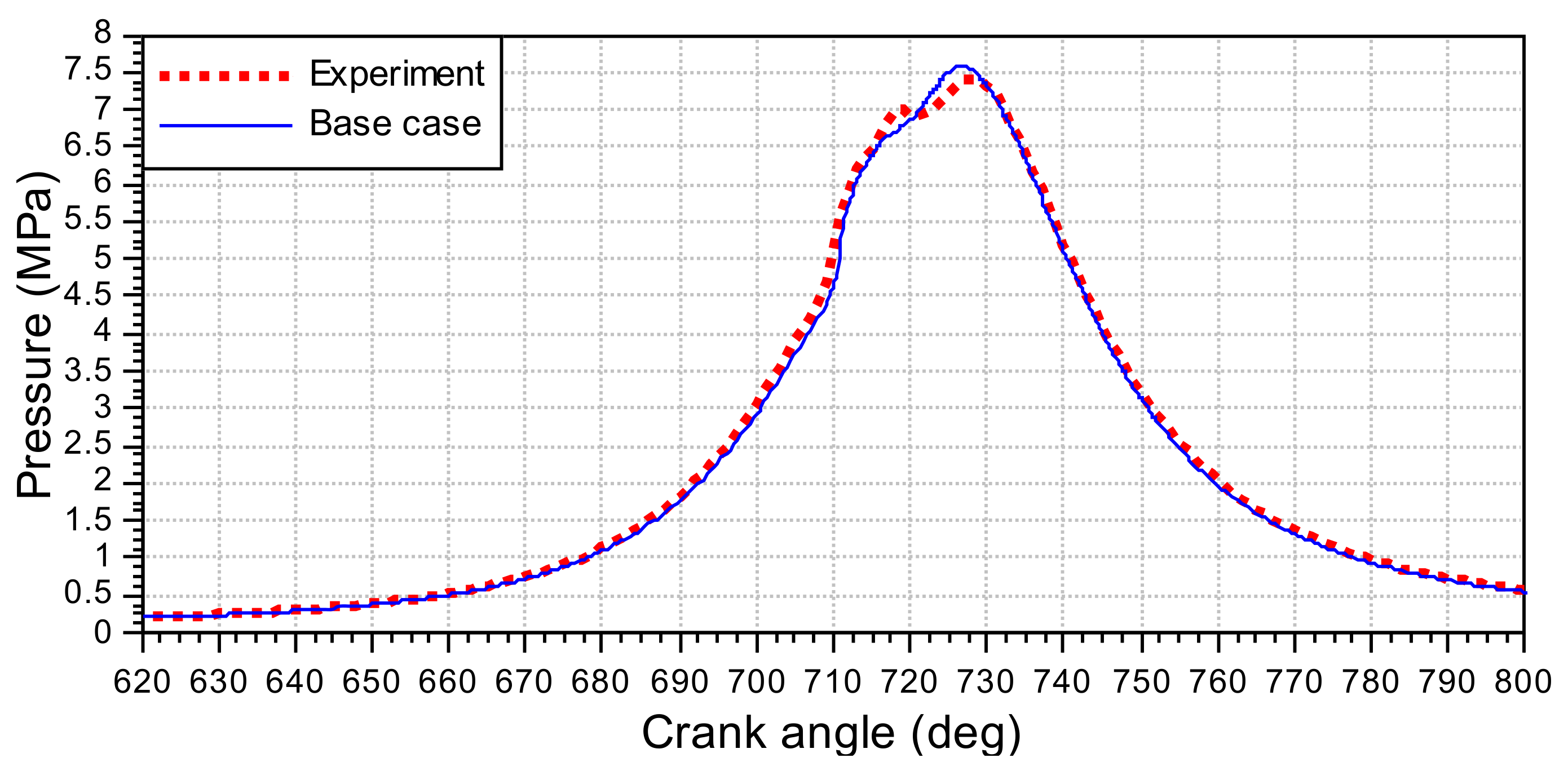
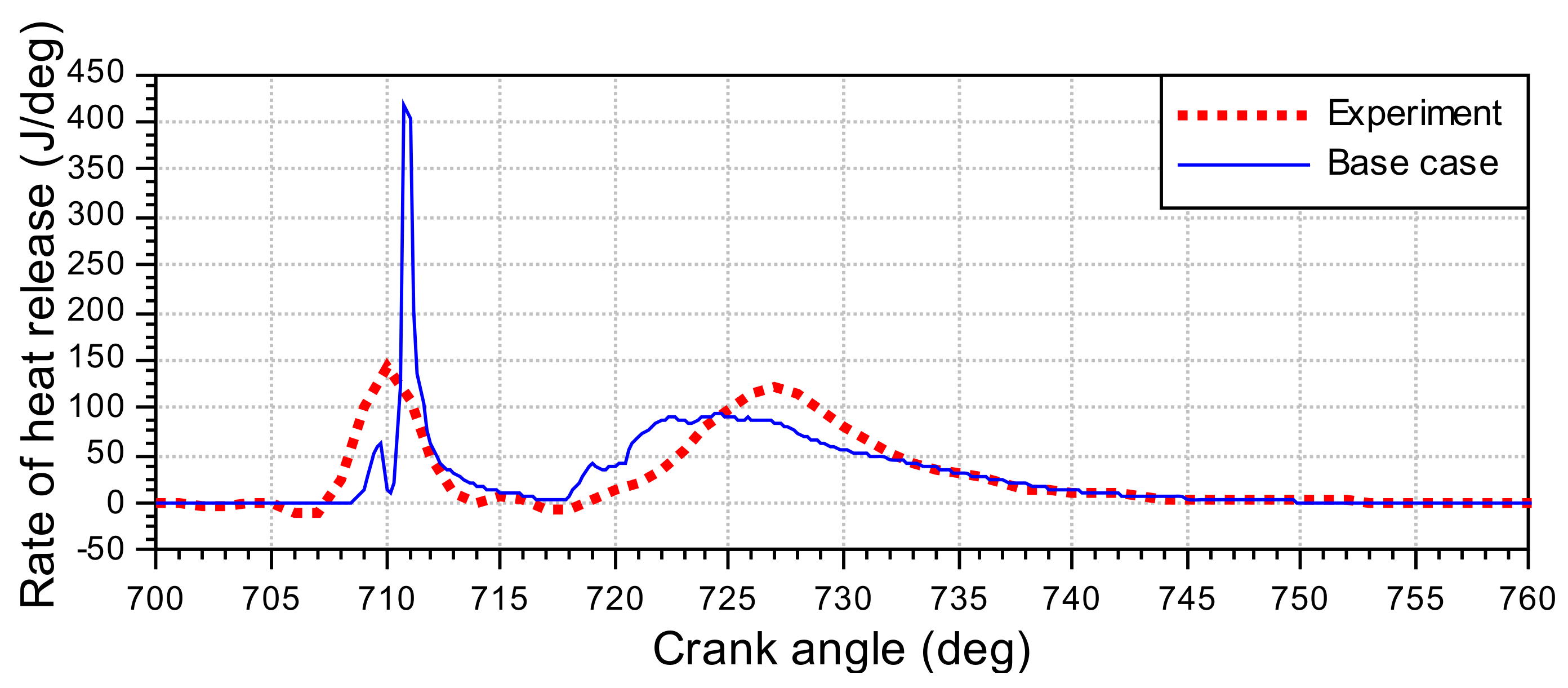
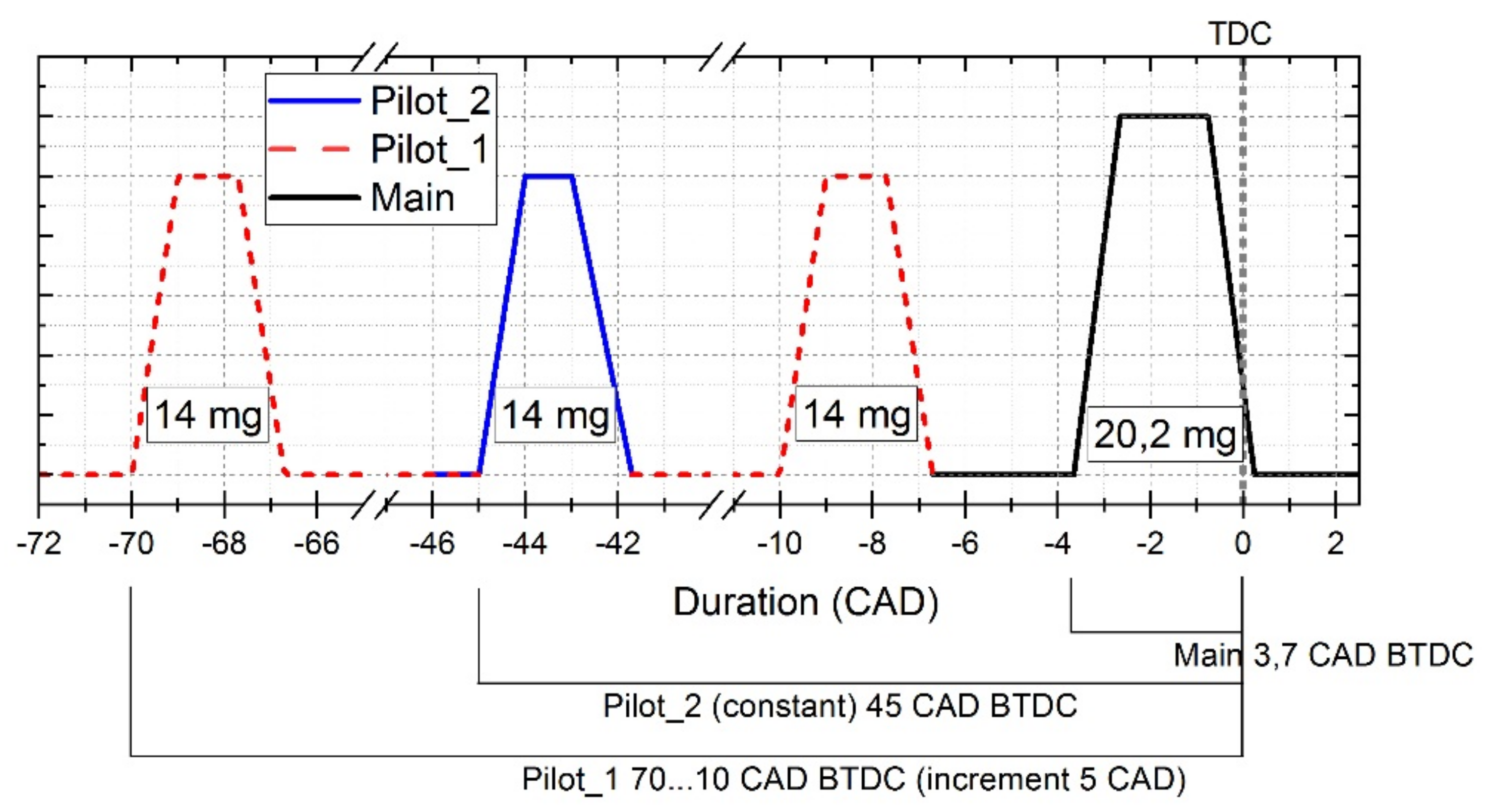



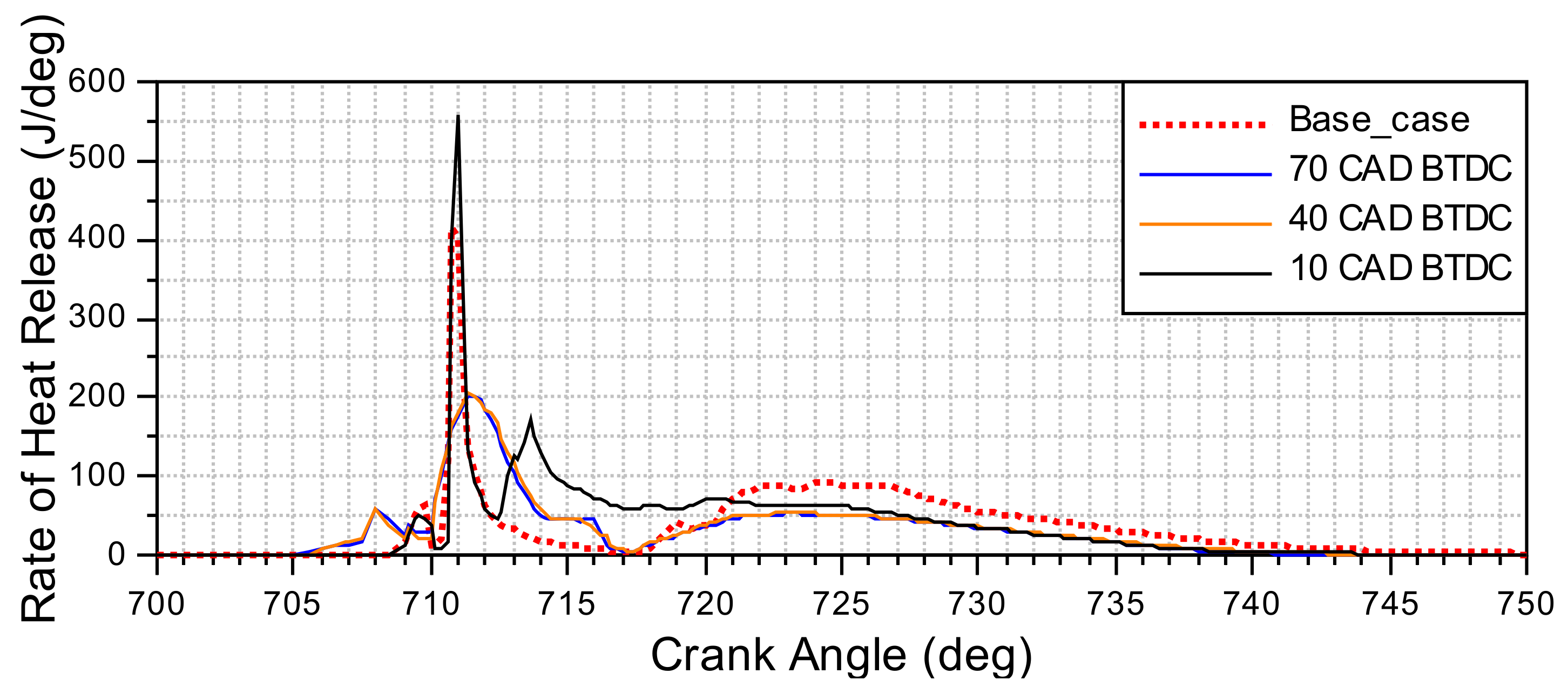
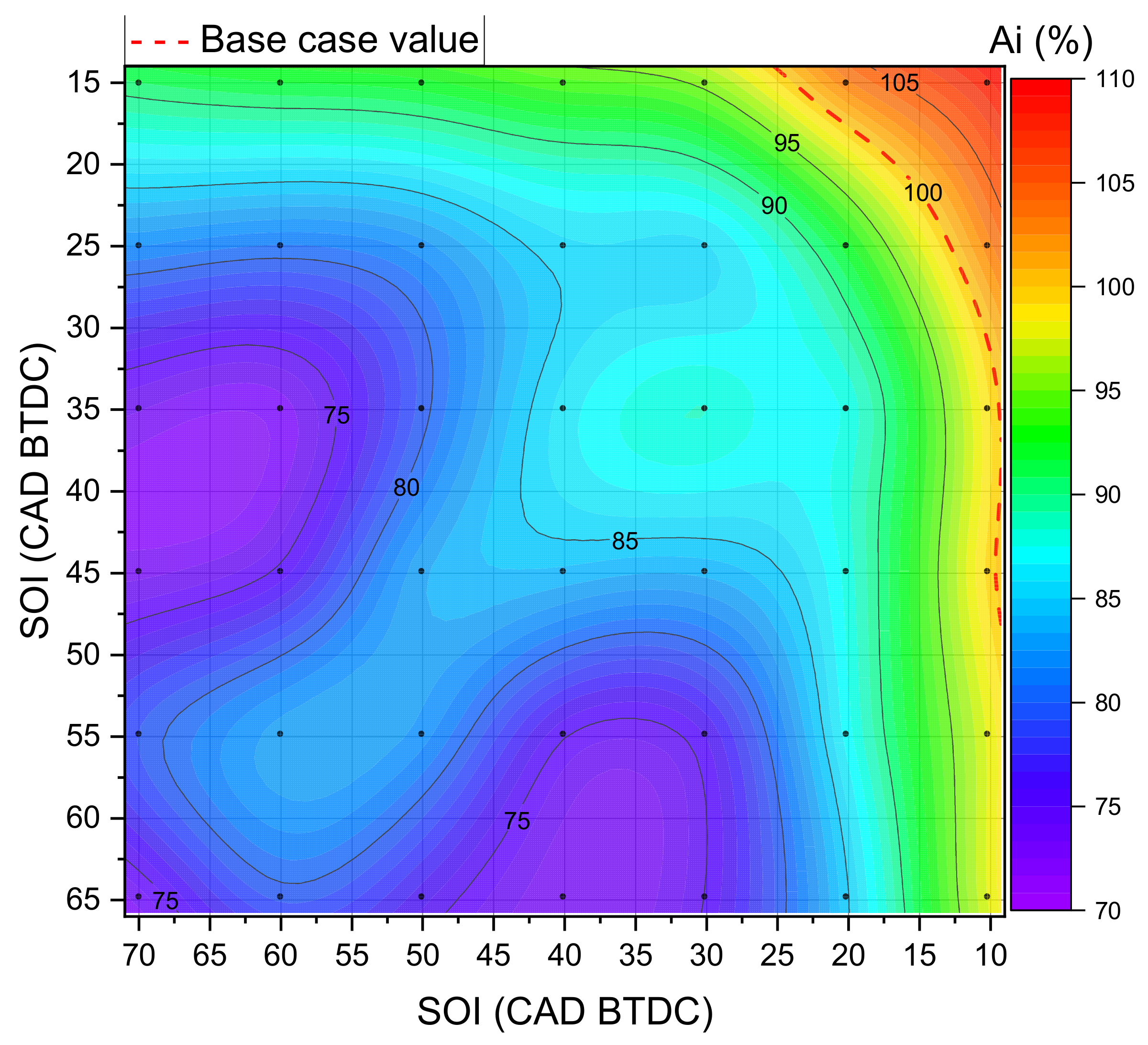
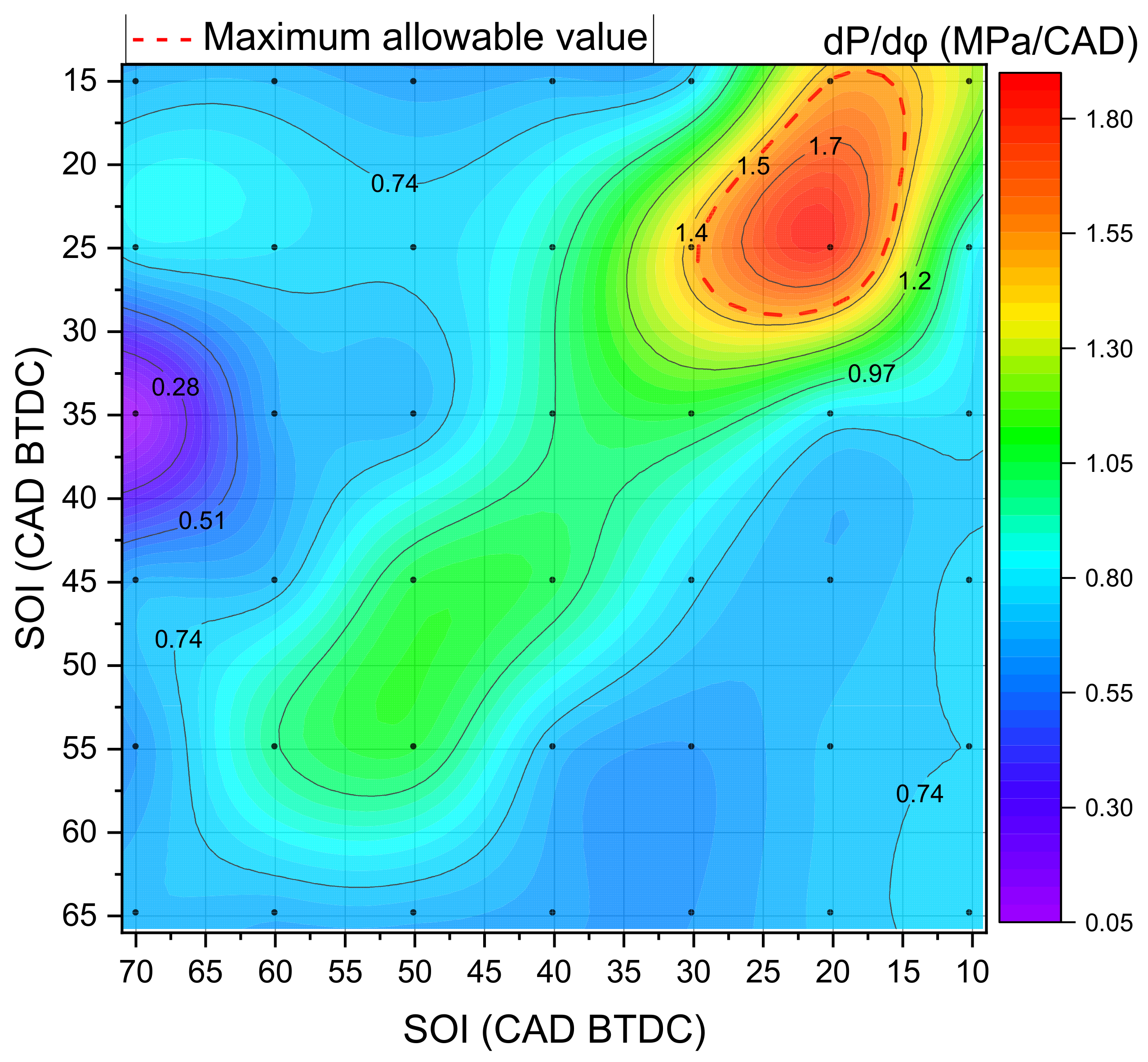


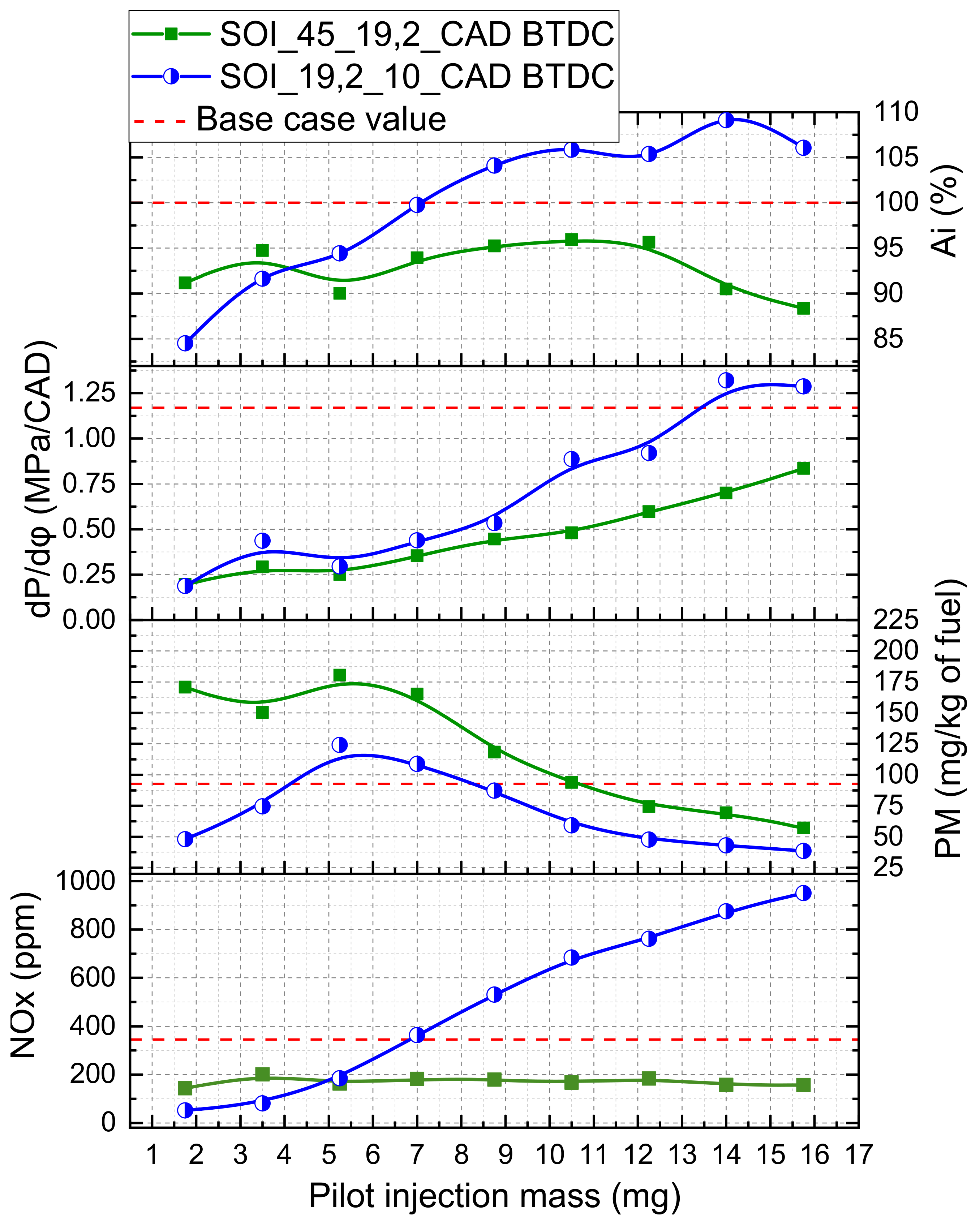
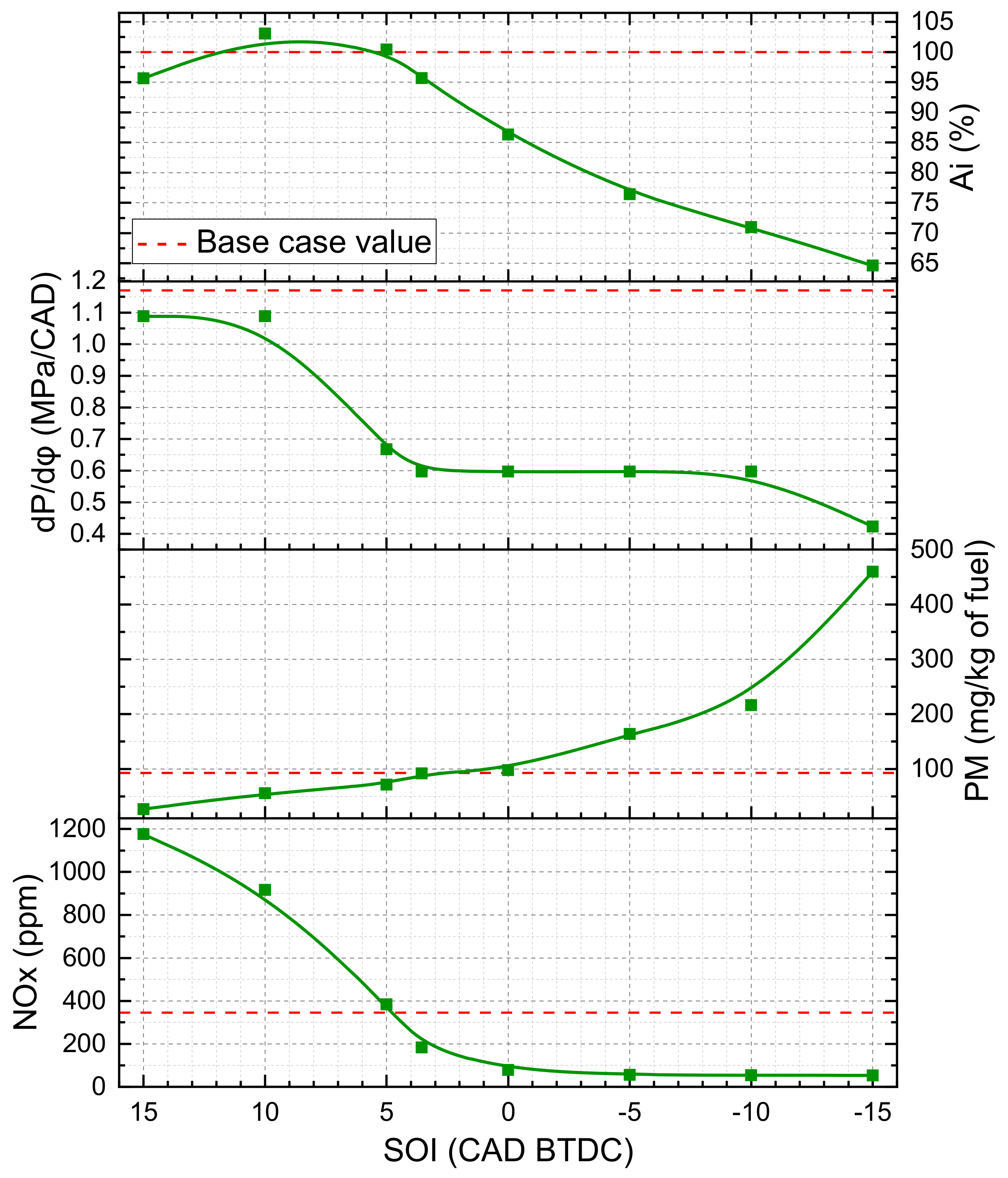



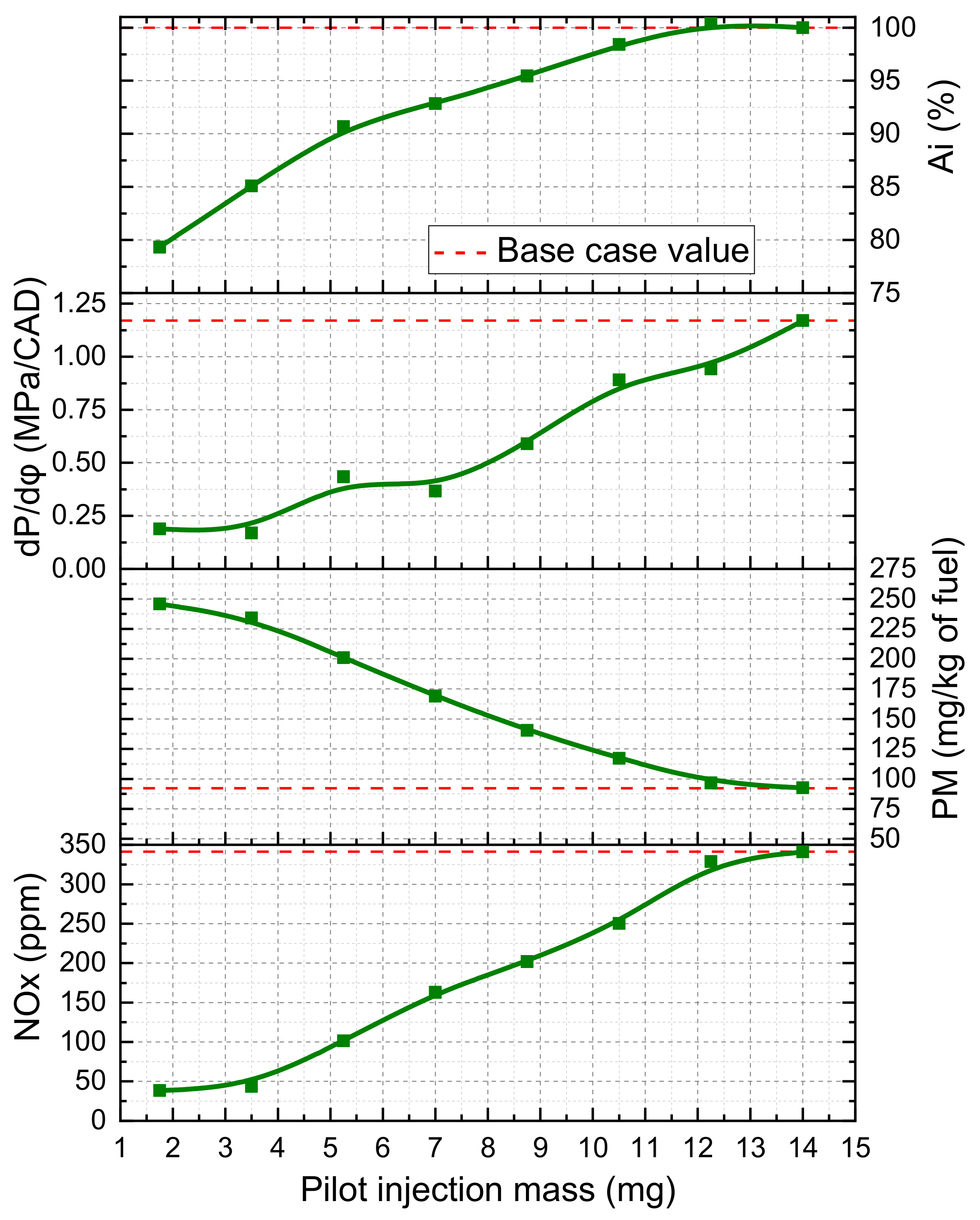
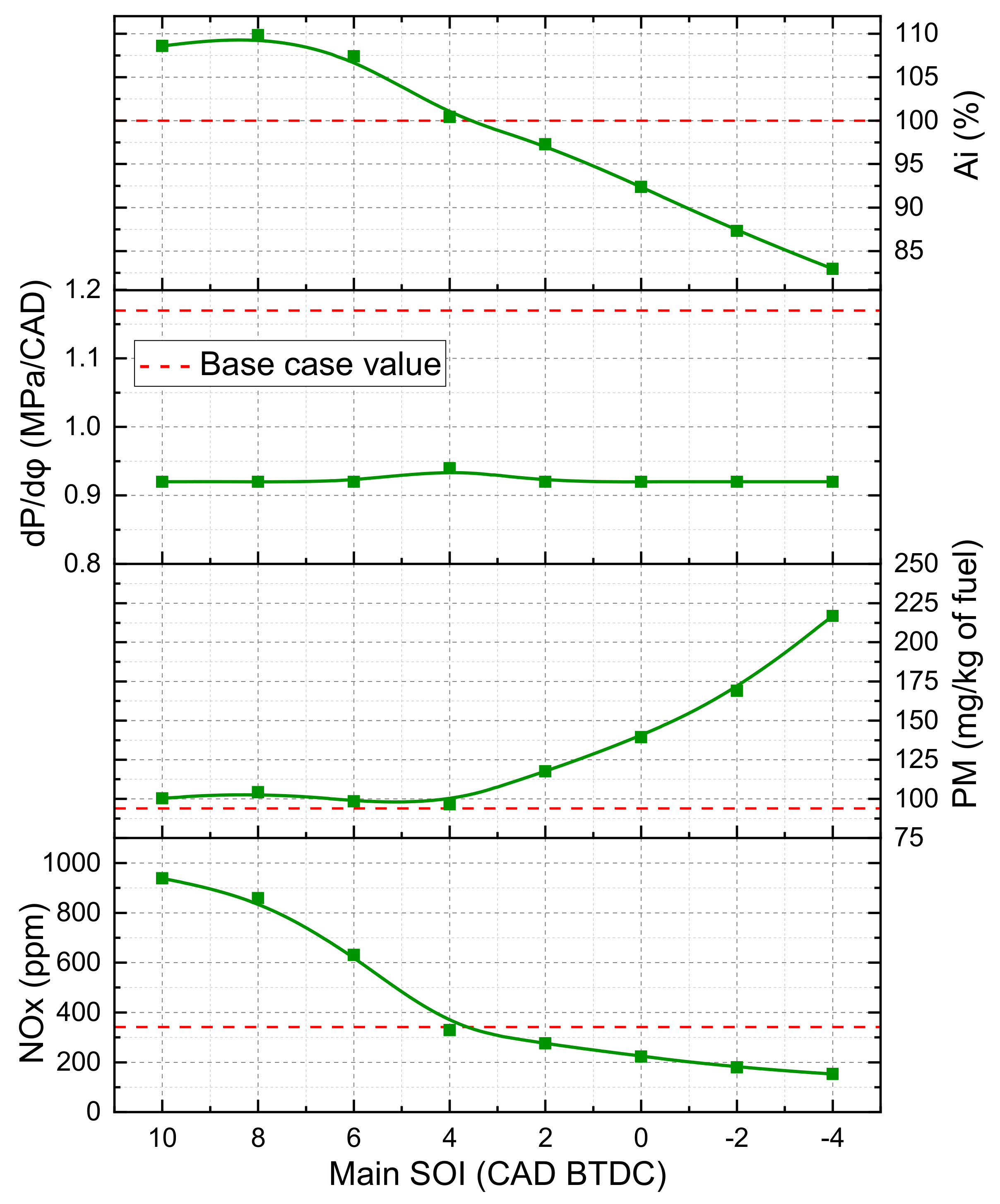
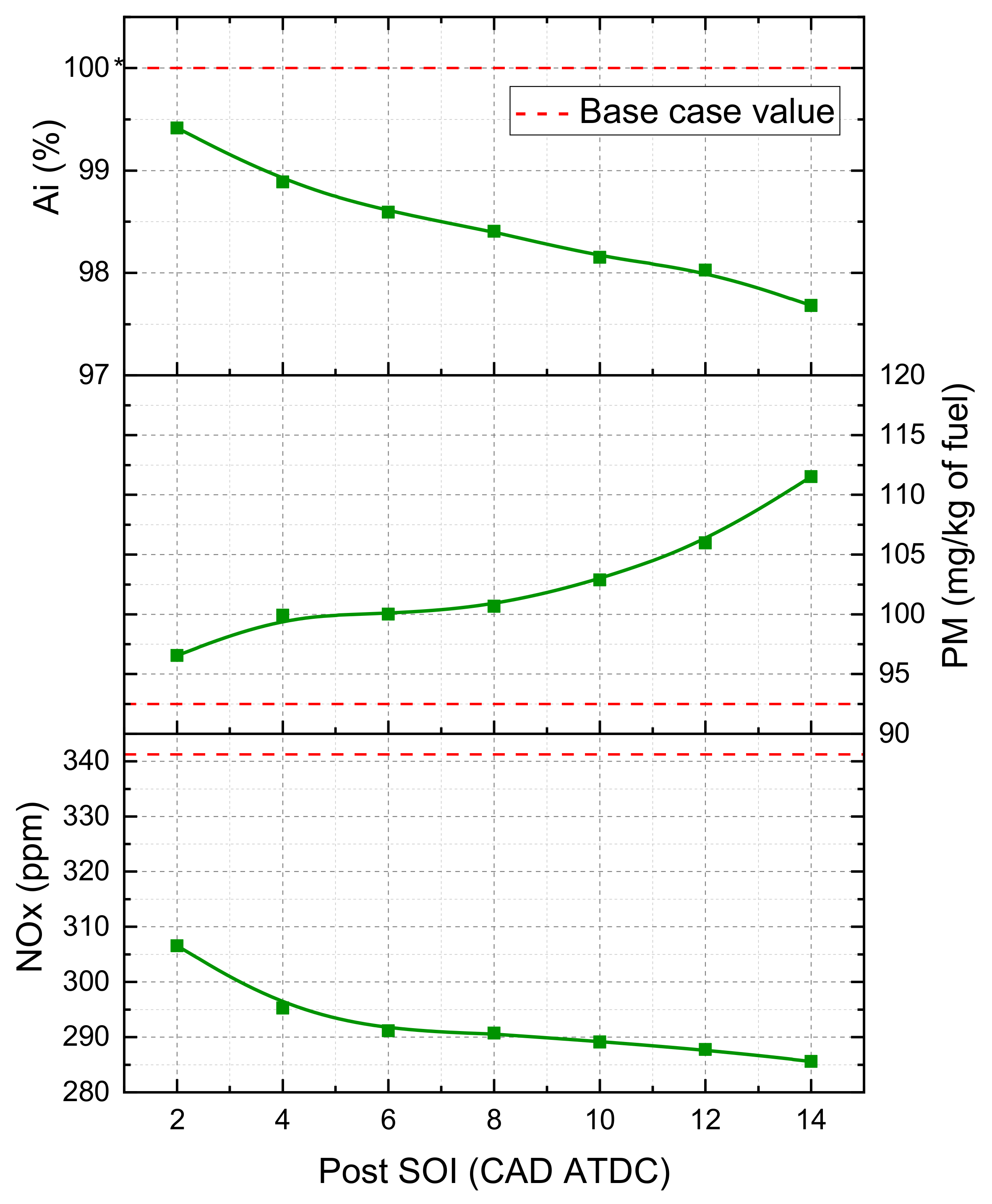
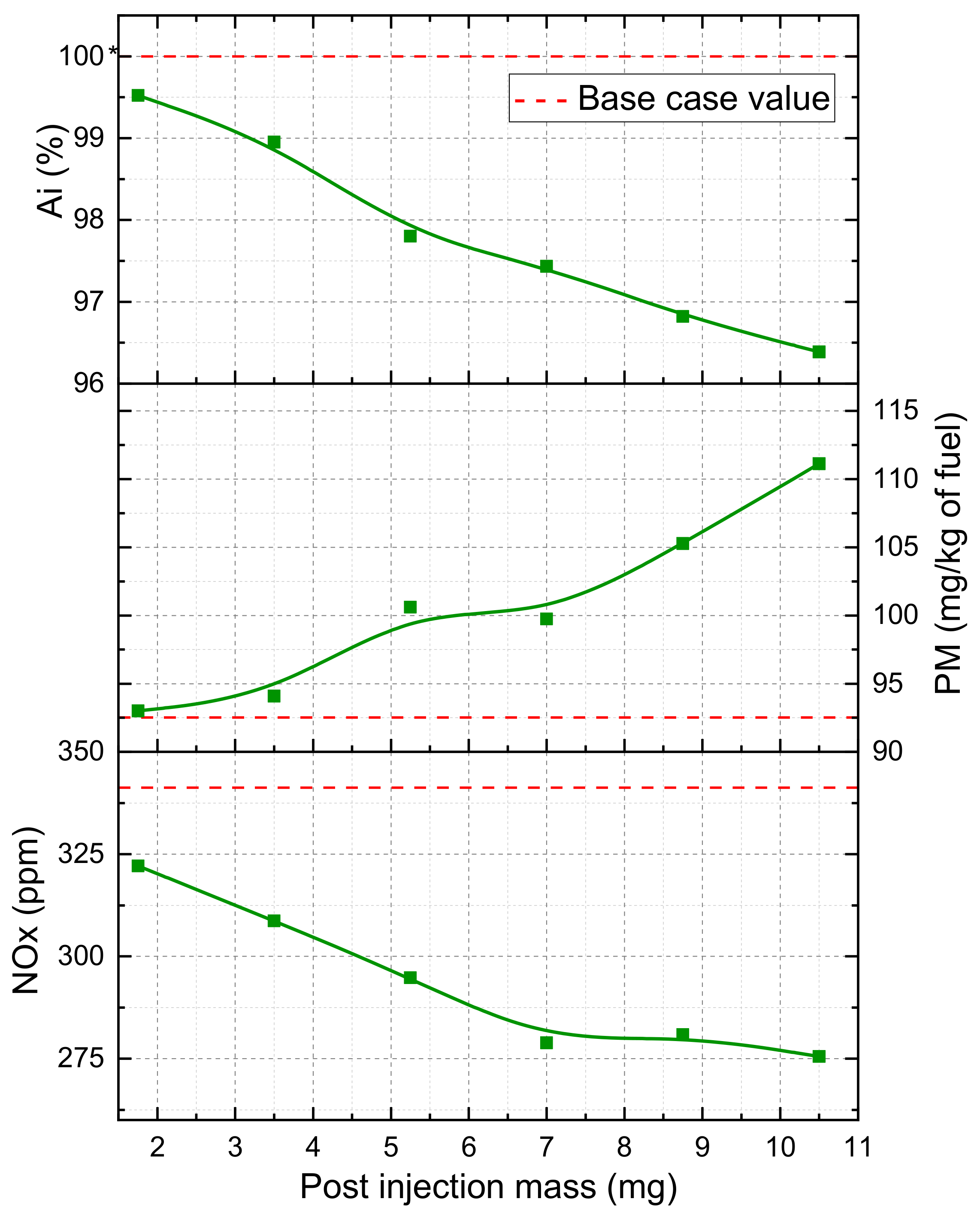



| Type of Results | SOI Pilot, CAD BTDC | Pilot Injection Mass, mg | SOI Main, CAD BTDC | Main Injection Mass, mg | NOx, ppm | PM, mg/kg Fuel | Δp/Δφ, MPa/CAD | Ai, % |
|---|---|---|---|---|---|---|---|---|
| Experiment | 19.2 | 14 | 3.7 | 34.16 | 280 | 0.6 | 102.3 | |
| Base case | 19.2 | 14 | 3.7 | 34.16 | 341.3 | 92.5 | 1.15 | 100 |
| 1-st Pilot SOI | SOC, CAD | CD, CAD | EOC, CAD | AHR, % | CO, % | Ai | Acompr |
|---|---|---|---|---|---|---|---|
| Base case | 708.5 | 22.91 | 731.4 | 100 | 100 | 100 | 100 |
| 70 | 705 | 21.45 | 726.5 | 72.9 | 609.1 | 76.7 | 104.0 |
| 40 | 705 | 21.7 | 726.7 | 83.4 | 412.1 | 85.7 | 104.7 |
| 10 | 705 | 23.4 | 728.4 | 94.4 | 236.9 | 100.1 | 101.9 |
| 1-st Pilot SOI | SOC, CAD | CD, CAD | EOC, CAD | AHR, % | CO, % | Ai | Acompr |
|---|---|---|---|---|---|---|---|
| Base case | 708.5 | 22.91 | 731.4 | 100 | 100 | 100 | 100 |
| 70 | 705 | 22.65 | 727.7 | 92.6 | 268.5 | 98.5 | 102.4 |
| 40 | 705 | 23.25 | 728.3 | 95.0 | 223.6 | 100.4 | 101.9 |
| 15 | 710.8 | 18.6 | 729.4 | 102.8 | 69.7 | 107.2 | 101.1 |
| Pilot Mass, mg | SOC, CAD BTDC | CD, CAD | AHR, % | CO, % | Acompr, % | Ai, % |
|---|---|---|---|---|---|---|
| 14 (base case) | 11.5 | 22.9 | 100.0 | 100.0 | 100.0 | 100.0 |
| 1.75 | 1 | 20.1 | 91.9 | 295.4 | 93.2 | 79.3 |
| 7 | 10 | 25.4 | 97.4 | 148.4 | 95.5 | 92.9 |
| 12.25 | 11 | 23.1 | 100.3 | 98.0 | 98.8 | 101.5 |
| Pilot Mass, mg | SOC, CAD BTDC | CD, CAD | AHR, % | CO, % | Acompr, % | Ai, % | NOx, % | PM, % |
|---|---|---|---|---|---|---|---|---|
| Base case | 11.5 | 22.9 | 100.0 | 100.0 | 100.0 | 100.0 | 100.0 | 100.0 |
| 3 stage optimal | 11 | 25 | 100.4 | 94.8 | 98.7 | 99.0 | 90 | 105 |
Publisher’s Note: MDPI stays neutral with regard to jurisdictional claims in published maps and institutional affiliations. |
© 2021 by the authors. Licensee MDPI, Basel, Switzerland. This article is an open access article distributed under the terms and conditions of the Creative Commons Attribution (CC BY) license (https://creativecommons.org/licenses/by/4.0/).
Share and Cite
Zuev, N.; Kozlov, A.; Terenchenko, A.; Karpukhin, K.; Azimov, U. Detailed Injection Strategy Analysis of a Heavy-Duty Diesel Engine Running on Rape Methyl Ester. Energies 2021, 14, 3717. https://doi.org/10.3390/en14133717
Zuev N, Kozlov A, Terenchenko A, Karpukhin K, Azimov U. Detailed Injection Strategy Analysis of a Heavy-Duty Diesel Engine Running on Rape Methyl Ester. Energies. 2021; 14(13):3717. https://doi.org/10.3390/en14133717
Chicago/Turabian StyleZuev, Nikita, Andrey Kozlov, Alexey Terenchenko, Kirill Karpukhin, and Ulugbek Azimov. 2021. "Detailed Injection Strategy Analysis of a Heavy-Duty Diesel Engine Running on Rape Methyl Ester" Energies 14, no. 13: 3717. https://doi.org/10.3390/en14133717







